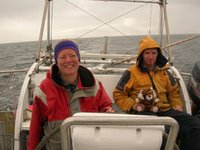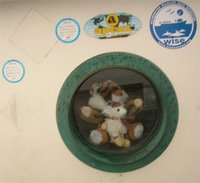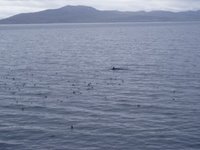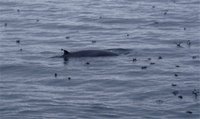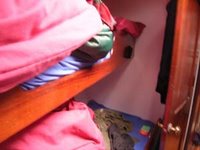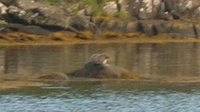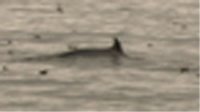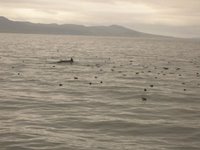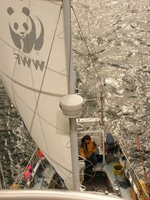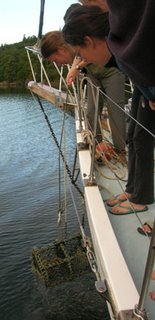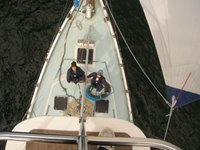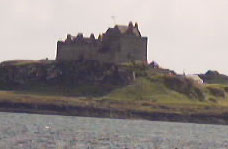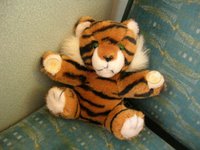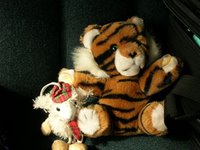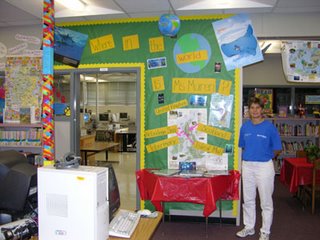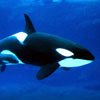



|
Whales and Dolphins of the Hebrides Tobermory, Isle of Mull, Scotland
Earthwatch Institute engages people worldwide in scientific field research and education to promote the understanding and action necessary for a sustainable environment. We believe that teaching and promoting scientific literacy is the best way to systematically approach and solve the many complex environmental and social issues facing society today.
| Hello, my name is Barbara Muren, Network Manager at Snively Elementary in Winter Haven, FL. I am also a Teacher Consultant with the Florida Geographic Alliance. The purpose of this site is to provide information about the project and a place to communicate Live from the Field with the students at Snively Elementary. The subjects we will be focusing on are science, geography, math, music, and technology. From August 27th to Sept. 2nd, I will post pictures and keep a journal of the daily activities aboard the research sailboat, Silurian. This is all possible through a generous grant given by National Geographic Education Foundation in support of the Earthwatch Education Fellowship Program and a grant from the National Geographic Education Foundation to promote geographic literacy through field research, technology, and collaboration. Thank You, also, to Polk County School Board, my principal, Dr. Joann McKinney, and all the teachers and students at Snively Elementary for their ongoing support. Especially Ms. Lambeth, thank you for making it possible to video conference. |
|
Where are the Hebrides?
The Hebrides are a group of inner and outer islands off the west coast of Scotland. This link www.whaledolphintrust.co.uk is a great description of the Hebrides and also includes a map. * Use this United Kingdom Map to find Tobermory, Isle of Mull, an inner island of the Hebridean Sea. It is our rendezvous point for this project. For a real cool view, use your Google Earth program and fly to Tobermory. What specific Whales and Dolphins are we researching? The focus of our research includes the harbor porpoise, minke whale, bottlenose dolphin, grey and common seals and basking sharks. * Check out: HWDT for great descriptions and images. Why are we collecting data on the Hebridean cetaceans? The information will identify particular areas of importance or "hotspots" for cetaceans. This will provide an effective conservation strategy, the conservation of marine environment. Results: economic and social benefits to the whole region and protected areas for the cetaceans. * Check out: HWDT Is there a specific time to do this research? This project has expeditions running from mid April till the end of September. Moreover, the community members of the area are thoroughly involved with the research. Even visitors can fill out an online form of their exciting sightings. * Check out: HWDT |
Tuesday, September 05, 2006
Tiger, sheepy, and I made it home
WOW, what an adventure it has been! By plane, bus, shuttle, train, car, ferry and my own two feet - we have seen practically all of Scotland, Orkney Island and the Hebrides!!! I'd like to first off say THANK YOU to Marcia McKinney for all of her help back at Snively. Without her many of the students would have missed out on this wonderful experience and for the valuable communication connection that she provided. Thank you to Dana Robertson, too, for her help with the Scotland travel bulletin wall and with the ITV program. Thank you to ALL the staff at Snively for giving your students the opportunity to virtually experience Scotland and the Cetaceans of the Hebrides. Thank you to HWDT for the opportunity to help with the conservation of this species and our environment. Thank you to Earthwatch Institute, the Earthwatch Education Fellowship Program, National Geographic Education Foundation, and the Florida Geographic Alliance to promote geographic literacy through field research, technology, and collaboration!!!!!!! Thank you to the Silurian crew - Peter, Gen, Laura, Hilda, Sarah, Louise, Lizzie, Karen, Jan, Tiger, sheepy, and friends. The spectacular cast in the Hebridean Islands. (Sighting - 100 meters) Oh yeah, Thank you to MOM and Barney for all of their loving support! CHEERS ALL! Love, Ms. Barb Muren
Friday, September 01, 2006
Back Home - Tobermory
Day 6 - Back home in Tobermory.
Another day of extreme weather changes. Never know what to expect here, except the highly likely occurance of rain being thrown horizontally at your face for at least 10 minutes of every hour. Not many sightings today but that was made up for by the whales yesterday. It feels very strange to be leaving...glad to be going home and getting back to loved ones, but very sad to be leaving the boat, the crew and the team. Strangely discovered that I am now land sick. I adapted to life on the boat without too much trouble but when I am on dry land now after a week the whole ground seems to tilt and shift. Very strange.
A great day. Really exhiliarating. The wind and the rain were blowing hard with a sea force of 6 at one point. It felt fantastic to be outside with the elements.I went up the crow's nest today. Something new and very exciting.
Thursday, August 31, 2006
Day 5 - Leaving Loch Tarbert Jurar

Going out of Loch Tarbert Jurar (N side of Jurar)and sailed out toward Colonsay - where we saw the Minke Whales and porpoises for about 2 hours. We left the inside of Colonsay and headed for the Garvellachs. Continued North to the Sound of Kerrara just off of Oban. We are at Lat 56 degrees 22.62N Lon 005 degrees 30.00 W. It's a beautiful night. We had a great day! Rain was intermitant. Mostly at the very last few minutes of our sighting duties for the day.
Being in the dinghy. After we'd been watching the whales for about an hour or so Laura decided it would be a good opportunity to take some photographs for the photo id library. It took Sarah and Karen less than a second to ask if they could join Laura and Peter in the dinghy. Within minutes the dinghy was in amongst the manx shearwater and other feeding birds. Then one whale came up on starboard, then another. They surrounded the boat as they all fed heartily. At one point one whale came up inches away from the boat - we could feel the boat move as the whale surfaced. We couldn't get the camera to work but we have some fantastic views - it really felt like we were right amongst them. You could smell the fish as the whales feed and the manx shearwater were diving beneath the boat to feed at the same time.
It was amazing watching the dinghy go out into the water. I was standing with Hilda at the bow watching the whales and the dinghy and then suddenly a whale soared up at the back of the dinghy. Sarah and Karen with Skipper Peter and scientist Laura were looking towards the front of the dinghy so didn't see it but certainly felt the impact. Those of us on the yacht just watched as the minke whale leapt out of the water to catch more fish showing its throat grooves. An unforgettable and indescribable moment! Take a look at one of the books on whales to see an example of a whales throat grooves.
We will be heading back to Tobermory tomorrow - anchor there, clean up the boat.
Day 4 - Anchored in Loch Tarbert Jurar
Day 4 – Wednesday Lat 55° 57.584N Lon 55° 55.048W Anchored in Loch Tarbert Jurar after passing through the Sound of Islay. We are met with wind gusts up to 25 knots and rain. It is mighty chilly for the Floridean – the Brits are even wimping. We had a quiet tour of
The Sound of Jura but there was a peak time of sightings of porpoises earlier on in the day. After that it was pretty quiet on the mammal watches. Lots of birds though which were charted and then recorded. We are all finding our sea legs and nobody seemed to feel sick today. A BIG relief! As we were sailing by the coast of Jura we could faintly see the top of Northern Ireland on the horizon. Observations are an important tool of our research on the boat. Try this observation technique. Find a quiet place on campus and observe how many birds you can identify and count in 15 minutes in a radius of 0-90°.
Wednesday, August 30, 2006
Day 4 - Leaving Loch Sween
Leaving Loch Sween heading South to survey the Southern part of the Sound of Jura. Then heading North up the Sound of Islay towards anchorage in West Loch Tarbert which is on the West Coast of Jurar.
Day 3 - Anchorage at Loch Sween

Day 3 – Lat 56 degrees 01.800N Lon 005 degrees 35.458W Air temp = 14 degrees C water temp = 11.1 degrees C. Tucked nicely by Loch Sween. We, (the brave ones) fancied ourselves with a brisk swim in the Loch. Of course, the Floridean dressed for the occasion. Seals were by but didn’t come close enough for an encounter. We ended our day with a top notch dinner – mussels, prawns and haddock with broccoli & crisp potatoes. What a gorgeous day it was! It was very windy at times but for the most part calm and sunny. We had a few sightings of seals and porpoises – no whales though. We have found that this research stuff is hard work. Well at least tiring. From the get go, we have breakfast, discuss our plans for the day – the route we plan to take and then it’s research time. We are broken down into pairs – two standing at the mask pole switching sides after a half hour, two collecting the data sightings – one which is perched at the computer & the other at the companion way, with the other two ‘off duty’. The pairs rotate every hour and we keep rotating until we reach our next anchorage. It is very important that we collect accurate data and on time data. For example, we need to do an environment conditions data collection every 15 minutes. Question for the day is “Why do you think it is important to have this environment conditions information for this sightings research?”
Tuesday, August 29, 2006
Day 3 - Leaving Loch Spelve
Day 3 – Lat 56 degrees 21.908N Lon 005 degrees 41.131 W. Air temp = 16 degrees C. Water temp = 53.6 degrees C. Touch of rain in the morning. For the most part sun peaking through the clouds. Leaving Loch Spelve going South down the Firth of Lorn through the Sound of Luing (note the tide rush is very strong here so it is important to get this spot before the tide is coming in as to not use as much gas) then past Scarba – which is a slate island into the Gulf of Corryreckan’ entering the Sound of Jura. We will make anchor somewhere by Loch Sween.
Day 2 -anchorage at Loch Spelve
Day 2 – anchorage at Loch Spelve. A few of us made a quick run to shore in a small rib, for a few last minute items. After being assured that all weather gear was not required it was typical that we all got absolutely drenched in a sudden summer downpour on our return to the Silurian. A humorous and very wet start to the first day of our adventures! The rest of us sure were pleased we’d decided just to hang out onboard in the dry as soon as we saw the state the others came back in!
It’s just amazing being out on the boat, so different from indoor and urban life.
I was determined to see mammalian life on my first watch today but was not lucky in that respect. There were enough sea birds to keep us entertained though (Gannets, Guillemots, Terns and Gulls) and the view was stunning. The weather is so changeable and can be completely different in every direction you look. Rainbows were appearing almost constantly, clinging low to the sea, and the cloud was low enough to touch the land in some places with sunbeams shining through. Having been relieved of duties for an hour I took the opportunity to climb up into the crow’s nest (with the reassurance of being tied on and winched by the skipper Peter in case I slipped). The view was incredible and the sense of peace was amazing. Soon I was rewarded with sightings of seals on a nearby island and soon after that a couple of animals swam by leaping out of the water as they went. Two of us were sure they were common dolphins but since we were very inexperienced the crew were unable to reliably record it as such and had to leave it as an unidentified dolphin sighting. They may have been harbour porpoises. It was a lot more scary coming down as the sea was a lot rougher by that point and I was very glad to be unable to fall to my doom. – Karen
Great day! Lots of learning about Hebridian sea mammals. More to come tomorrow, on bird life. We all got into our gear, very funny, as we all struggled with zips, lengths of trousers, life jackets! New experiences all round. The staff on the boat are fantastic, looking after us, making sure we don’t fall over board. Everyone is so patient with all our questions and mistakes. Looking forward to what tomorrow brings. – Lizzie
Monday, August 28, 2006
Air and water
The air temp = 14 degrees C and the water temp = 24 degrees C. Students using the conversion formula, figure out what these temperatures would be in Farenheit.
Also, you can begin asking questions through this blog using the comments link to each post or posting a new one through Mrs. McKinney.
Day 2 - Leaving Tobermory
Day 2, Leaving port around noon. Lat N56° 37.205 Lon 06° 03.681 Air Temperature 14° our plan is to head S down the Sound of Mull and anchor at Loch Spelve off of Firth of Lorn. This first leg of our journey is around 20 miles. We hope to see harbor porpoises. August & September is the time when they are calving –so, we should see mother with calf. They are hard to sight because they are so quick when they surface. They prefer areas with a varied topography, because of the nutrients that is found in these areas. The bottlenose dolphins are mainly a coastal species. The left side of the fin is used for photo research. Along with identifying Male – 1 slit Female – 3 slits. They are very social and like to hang out in 2 or 3’s. Common Dolphin feed on mackerel and herring found in large groups of 50 up to 500. They are fast moving and highly active. Minke Whale is an untoothed cetacean of the rorqual whales. They filter their food through their baleen and feed on sandeels, herring, and sprat. They are usually found on their own. Other species we might observe: Killer whale (Orca), Risso’s Dolphin, Humpback Whale. The software program, Logger, is used to map the sightings. The data recorded are species, distance, bearing, heading, number of animals, behavior, any other species associating (birds, etc.), boat traffic, and rubbish. See if you can look at the pictures of these species and compare & contrast their appearance. The thought is “Where would you most likely be if you were a cetacean?”
Day 1 Tobermory
Day 1, Sunday – For the expedition, it began at 6pm. Light – mid rain. 16 degrees C. We gathered at the HWDT visitor center then walked to the sailboat a little ways down the road. With a welcome from Skipper Peter, we boarded the Silurian with the smell of dinner in the air. Our height determined our sleeping bunk. I’m in the furthest forward section of the boat with Karen from London. The evening was spent with getting acquainted with each other while having tea and cookies and going over the safety & boat particulars, - The top of the lists: To flush the loo -pump the handle twenty times (with the lid closed). The location of the satellite beacon in case we need to send an SOS and the rescue team can find us using GPS. Take the karabiner on your life jacket and attach it to the rope line that runs along the floor topside. This will keep you from falling completely overboard – now that’s a pleasant thought.
Sunday, August 27, 2006
Sunday night - Anxious
The views here are beautiful. It seems like a melting pot of the cities of the USA. The beaches, lochs and rivers like FL - the wind sometimes like Chicago, IL - the rain and climate like Seattle, WA. The temperatures have been ranging from 13-18 degrees C. It has rained almost everyday but it comes and goes. I have learned so much about the Scotland way. The people are very nice and helpful, especially to a young female trying to find her way. Keep checking the Marquee above for equilvalent sayings. For ex. To Let = For Rent; Eeye = Yes. The usual diet has gone to the way side - eating fish & chips. But with all the walking here and there, Tiger, Sheep & I will be okay. Well, need to go. Internet here is .89 a pound for 15 min.'s. I'm excited and very anxious about the sailboating. My stomach has been dancing all day. I bought wrist bands and dramamin to hopefully way the sea sickness. Cheers for now! Be sure to get with Mrs. McKinney or Mrs. Mastrangelo to post any questions.







